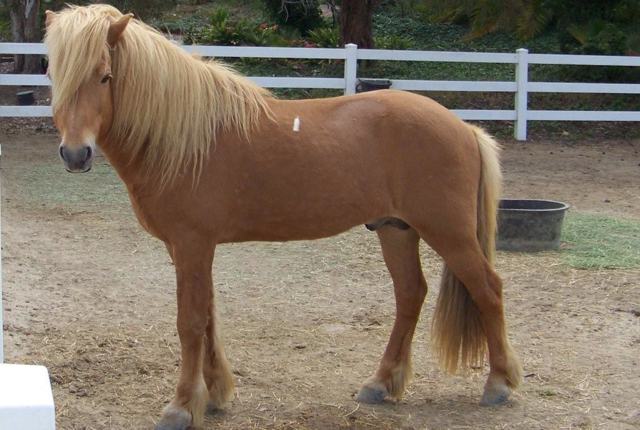Icelandic Horses are fascinating creatures. Brought to Iceland by the Vikings, they have been bred in isolation since about 930 A.D. when the government banned the import of all other animals into Iceland. They have been crucial to the survival of Icelanders even into the 20th century. They have continued until very recently to be a means of transportation and in the past worked in the fields and at all times have been necessary to life in an often dangerous and stressful environment.
Icelandic culture embraces its horse. With a human population nearing 300,000, there are an estimated 100,000 Icelandic Horses on the island. There are riding halls and clubs in most towns and practically everyone learns to ride as a child. Recreational riding over rugged terrain is enjoyed by the very young through the very old in Iceland.
The Icelandic Horse is deeply affected physically and psychologically by its upbringing. Icelanders give their horses time to grow and mature before they begin their training. They are allowed great freedom as foals and youngsters, running with herds of up to 700 horses in the mountains, freely grazing and seeking water, usually until age four or five. Coping with the environmental challenges, the horses develop independence and the ability to think in difficult situations. Since there are no predators to threaten the horses in Iceland, the mares have no need to teach their foals to run from anything. This allows the horse to develop a level of confidence and power that is invaluable to his reasoning skills as a riding horse and his contribution to the rider/horse relationship.
The average Icelandic Horse is from 13 to 14 hands. He weighs 750 to 900 pounds and is four or five-gaited, offering not only walk, trot, and canter but also two lateral gaits—tolt (similar to the rack), and, if five-gaited, the flying pace. He is brave, sturdy, strong, powerful, friendly and polite, with unusually strong bones, joints and coupling that allow him to easily carry adult riders, and has a serious work ethic. In addition to these qualities, they are also quite beautiful with long, thick manes and tails and feathering on their legs. They come in all colors, many quite dramatic, such as silver dapple, pintos in all colors, duns and even some called “Color Changers” which are different colors in different seasons.
Since their lateral gaits are in addition to walk, trot, and canter, Icelandic Horses can be ridden in all disciplines. They excel as pleasure-riding horses, able to deal with difficult terrain and untroubled by sights and sounds that often terrify other horses. They compete in dressage and driving and have won national awards in Endurance competitions. They are part of several hunt clubs, jumping stone walls and obstacles with ease. They teach youngsters and oldsters about the pleasure of riding, offer an exhilarating ride when pacing and a floating, smile-evoking ride when tolting.
Iceland is a unique environment. If you travel to Iceland you can ride Icelandic Horses in their natural environment, across meadows, through rivers, herding sheep, always enjoying the comfort and security of a horse that is sure-footed and smooth to ride.
National Icelandic organizations throughout the world are joined together in an international organization that is dedicated to protecting the welfare of the breed and to maintaining the breeding, performance, raising, training and keeping traditions that have produced this unique horse. This organization regulates competition and breeding as well as many other activities with the result that there is one Breeding Standard, one set of competition rules, and one set of registration requirements for Icelandic Horses throughout the world. There is an evaluation system that allows the horses to be judged against internationally agreed upon standards in conformation and performance to promote the continued improvement of the breed. Judges are rigorously trained and certified to achieve uniformity in judging throughout the world.
The member association for the United States is the United States Icelandic Horse Congress which sanctions competitions and evaluations throughout the country, maintains the Registry in accord with the international rules, publishes a quarterly magazine and encourages the development of Regional Clubs formed by and for Icelandic Horse owners. To learn more about the Icelandic Horse, visit the USIHC website at www.icelandics.org.

